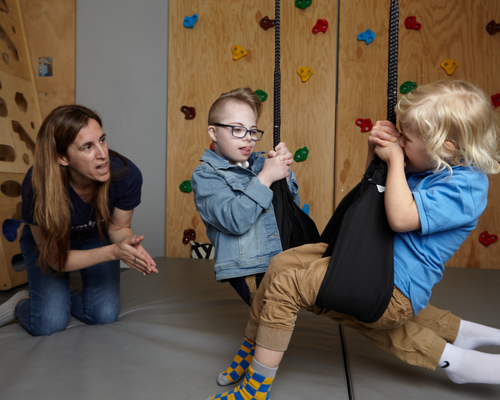How to support your child’s sensory needs this summer.
For many kids, summer is a time for fun, play, rest and discovery. But summer can be difficult for kids with sensory-processing challenges. Children who experience difficulties with sensory processing may find it challenging to enjoy summertime activities, and parents may find it challenging to meet their child’s sensory needs.
Here are some tips and strategies for supporting your child’s sensory needs and helping them feel comfortable and regulated throughout the summer months.
Understanding Sensory Processing and Challenges
Sensory processing refers to one’s ability to register and organize sensory input, from both internal (within one’s body) and external (environmental) stimuli, in order to effectively participate and engage in daily activities. An individual with sensory-processing challenges may have difficulties with effectively integrating and interpreting sensory stimuli, resulting in maladaptive behaviors, withdrawal or seeking of sensory input. Children with sensory-processing challenges can demonstrate difficulties engaging in daily and age-appropriate activities that require integration of sensory input from the different sensory systems such as touch, taste, smell, sight and sound, as well as from internal systems such as the vestibular and proprioceptive sensory systems. In turn, participation in summer activities, which often take place outdoors or in environments that have increased social attendance, may be impacted.
For example, a child with sensory-processing challenges may be overstimulated by loud noises, bright lights or strong smells, resulting in poor attention to tasks or the need to move away from the environment. Others may have difficulty with certain textures, such as scratchy clothing or sand, causing them to avoid certain activities such as going to the beach or the park.
Alternatively, some children with sensory-processing issues may seek out sensory input, such as spinning or jumping.
Supporting a Child’s Sensory Needs Through Summer
- Create a sensory-friendly environment.
Creating a sensory-friendly environment can help a child feel more comfortable and in control. This can be done by designating a space in your home where your child can retreat to when feeling overstimulated or dysregulated. A small tent or a corner with some pillows/bean bag chair, a weighted blanket or a lap pad, weighted stuffed animals, soft lighting and some fidget toys often works when trying to help your child regulate.
When doing activities outside the home environment, consider attending these activities when the environment is less crowded. If you can’t avoid the crowd, use noise-cancelling headphones, locate a quiet spot where you can direct your child to take a break, bring a few fidget toys and/or a weighted stuffed animal, and take breaks as needed.
- Engage in sensory-friendly activities.
Sensory-friendly activities can provide a great opportunity for a child with sensory-processing difficulties to engage in summer fun. Remember to always supervise your child when engaging in the following activities.
- A sensory bin or a kiddie pool filled with water, water/beach toys, colored ice cubes and sponges can provide tactile input and keep your child cool on a hot summer day. Other ideas for sensory-bin fillers during summer can include sand or kinetic sand, uncooked beans, shaving cream or whipped cream, and cooked noodles.
- Swimming provides both tactile and proprioceptive input and can be very regulating for kids that can tolerate the swimming pool. Consider going to the pool during less busy times to avoid sensory overload, if you know your child is sensitive to noise or crowded places. Also, consider visiting an outdoor pool as these tend to be less noisy.
- Visit your neighborhood park early in the morning or later in the day. Encourage your child to climb on the play structure and swing to provide vestibular input.
- Consider activities such as nature walks, where your child can explore different textures such as grass, rocks and leaves.
- Establish a routine.
Establishing a routine during summer break can help your child with sensory-processing difficulties feel more secure and in control. This routine should include sensory-friendly activities and sensory breaks. Sensory breaks can be as simple as taking a break from a stimulating environment or engaging in calming activities such as deep breathing or yoga. Additionally, establishing a consistent sleep schedule can help a child with sensory-processing challenges feel more rested and prepared to engage in summer activities.
Related Posts
- Find the Right Summer Camps for Your Child
- 3 Wellness Tips For Parents Of Kids Recently Diagnosed With Autism
- Stay hydrated.
Staying hydrated is important for everyone, but especially for a child with sensory-processing issues. Dehydration can worsen sensory issues and make a child feel uncomfortable and irritable. To ensure that your child stays hydrated, provide plenty of water and fluids throughout the day, and encourage your child to drink water frequently, especially during hot summer days. You can also provide water-rich fruits and vegetables, such as watermelon, cucumbers and oranges, to help keep your child hydrated.
- Dress appropriately.
Dressing a child in comfortable and breathable clothing is important, especially during the hot summer months. Avoid clothing with tags, rough textures or anything that can irritate the skin. Additionally, consider the type of shoes a child wears. Shoes with good support and cushioning can help a child feel more stable and comfortable during physical activities. When choosing clothing for your child, look for clothing that is soft, comfortable and fits well.
- Plan ahead.
Planning for outings and events can help ensure that a child’s sensory needs are met. For example, if you’re going to a noisy event, plan on bringing your child’s noise-cancelling headphones or earplugs. Additionally, if you’re going to a new place, consider showing your child pictures of the new environment and talk about the different sensory stimuli they may come across — including the smell of food, noises, bright colors, lots of movement, people standing in close proximity, etc.
- Be flexible.
Being flexible and willing to adjust plans is important when supporting a child with sensory-processing difficulties. It’s important to be tuned to your child’s behaviors and respect their sensory needs. If your child becomes dysregulated, stop the activity and either take a break or switch to another activity. Never force your child to participate in an activity that makes them feel uncomfortable or overstimulated.
Remember, every child is unique and what works for one child may not work for another. By understanding and supporting your child’s sensory needs, you can help them have a fun and enjoyable summer.
Avital Shuster is a pediatric occupational therapist and the clinical director of Tumble ‘N Dots Pediatric Therapy in Irvine. She received her bachelor’s and master’s degrees in occupational therapy from the University of Southern California. In her free time, she loves to spend time with her family and pets, go to the beach and travel. Please visit www.TumbleNDots.com or follow @TumbleNDots on Instagram for more information.









Leave a Reply